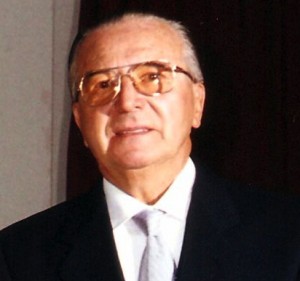Paul emigrated to the U.S. in 1939 from Berlin, interrupting his graduate studies in pre- World War II Germany to attend Auburn University where he completed his B.S. degree in less than one year. Following his graduation, he worked as a researcher at the Bartol Research Foundation of the Franklin Institute in Swarthmore, PA. He later moved to the Massachusetts Institute of Technology where, as an electronics engineer, he participated in the development of LORAN, a long range radio signal-based aid to navigation.
Paul joined Mobil Research and Development Corporation in 1946 as a Research Associate at Mobil’s Paulsboro, NJ research laboratory. He progressed through a number of technical assignments, reaching the position of Senior Scientist, the highest technical position in Mobil in 1961. He managed Mobil’s Exploratory Process Research organization from 1967 until 1969 and its Central Research Laboratory in Princeton, NJ from 1969 through 1982. Paul retired from Mobil in 1984.
Shortly after joining Mobil, Paul became interested in the subject of diffusion and catalysis. This was the foundation for a lifelong interest in porous materials as catalysts and specifically in crystalline hydrous aluminosilicates known as zeolites. Along with several Mobil collaborators, he pioneered the use of natural and synthetic zeolites as catalysts for petroleum refining and petrochemical manufacture. These zeolite catalysts eventually revolutionized many refining processes because they facilitated only certain reactions between molecules having specific dimensions.
In 1960, Paul published a ground-breaking paper co-authored with Vince Frilette, another Mobil scientist. This became the foundation of “shape-selective catalysis” concept, and also one of Paul’s widely cited papers (J. Phys. Chem., 64, 382 (1960)). Processes based on Paul’s concept of shape-selective catalysis were first commercialized in the early 1960’s. Throughout the 1970’s and 1980’s Paul was closely associated with Mobil’s development of new catalytic materials and the processes that were developed around them.
While working at Mobil, Paul took a sabbatical in 1964 to earn his doctoral degree from the Eidgenossische Technische Hochschule (ETH) in Zurich, Switzerland in 1966. His doctoral research thesis was based on an analysis of the permeation of dyes into fibers. His analysis was the foundation for some of the fundamental laws associated with diffusion of dye molecules into fibers.
One of Paul’s formidable strengths was his ability to communicate complex theories succinctly. He was a constant contributor to the ACS publication ChemTech throughout the 70’s and 80’s where he continued to enlighten and delight readers with his insightful observations of how phenomena like diffusion and kinetics applied to everyday life.
His 1962 article with J. S. Hicks, entitled “The Behavior of Porous Catalyst Particles in View of Internal Mass and Heat Diffusion Effects,” Chem. Eng. Sci. 17, 265 (1962) was selected as one of the 50 most influential articles in Chemical Engineering Science in the publication’s 1995 “Frontiers in Chemical Engineering Science” commemorative edition.
After he retired from Mobil in 1984, he began a third, highly productive career, applying chemical and physical principles to biomedical research first at the University of Pennsylvania an then at Penn State. Working with Dr. Madeleine Jouille at U. Penn he synthesized molecules that mimic some of the healing properties of heparin, but that do not exhibit heparin’s potentially dangerous side effects.
For his numerous industrial research accomplishments and contributions to the science of catalysis, Paul earned many awards including: The E. V. Murphree Award in Industrial Chemistry from the American Chemical Society (1972), The Pioneer Award from the American Institute of Chemists (1974), The Leo Friend Award of the American Chemical Society (1977), the R. H. Wilhelm Award from the American Institute of Chemical Engineers (1978), the Lavosier Medal from the Societe Chemique de France (1983), The Langmuir Distinguished Lecturer Award from the American Chemical Society (1983), the Perkin Medal, from the American Section of the Society of Chemical Industry (1985), The Carothers Award from the American Chemical Society (1987), and the National Medal of Technology from President George H. Bush in 1992. He was elected to the National Academy of Engineering, one of the highest honors for an engineer, in 1977 and received an Honorary Doctorate (Sc.D. in technological science) from the Swiss Federal Institute of Technology in 1980.
Beginning in the early 1950’s Paul’s work at Mobil Oil with collaborators including N. Y. Chen, Vince Frilette, John McCullough, Dwight Prater, Jack Wise, Al Schwartz, Heinz Heineman, Fritz Smith, and others helped set the foundations for zeolite catalysis. His seminal work in the use of natural zeolites as highly shape-selective conversion catalysts set the stage for 50+ years of highly productive process research and revolutionized the refining and petrochemical industries. Paul’s ninety-one issued U.S. patents and more than 180 journal publications cover topics ranging from carbonaceous deposits on catalysts to chemical agents that impact the diffusion of drugs in human cells. Paul Weisz leaves behind a very rich scientific and technical legacy that has greatly impacted our academic and industrial catalysis research communities. His work continues to inspire chemists and chemical engineers working in the area of catalysis and biomaterials.
(Contributed by Thomas Degnan, Jose’ Santiesteban, and Dominick Mazzone)



